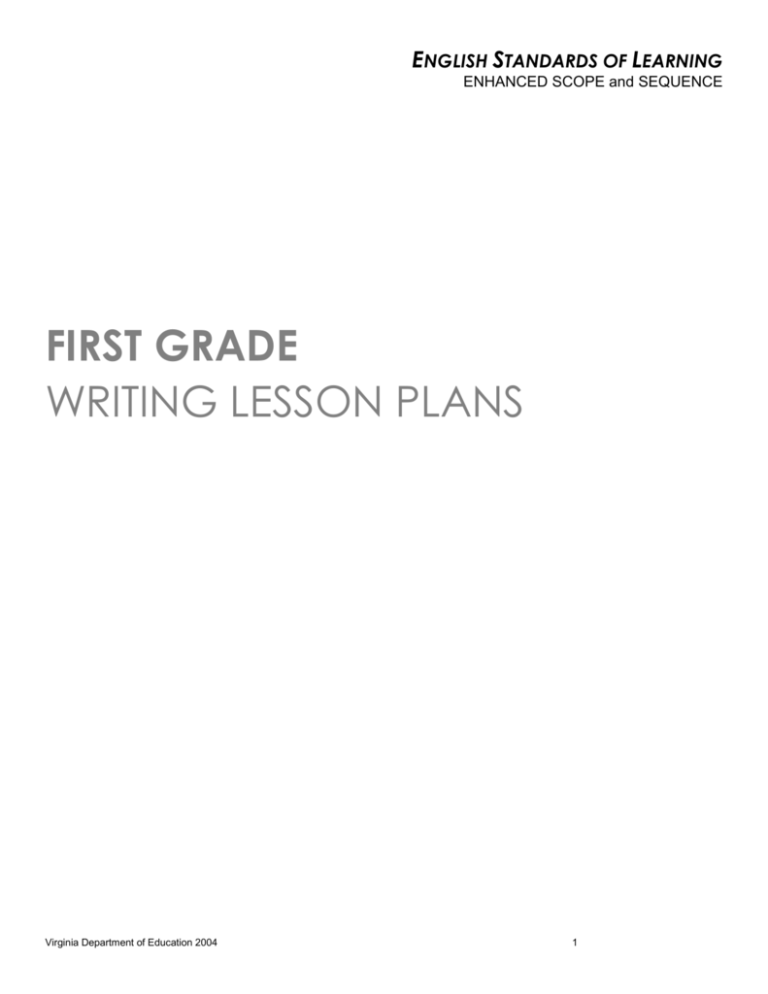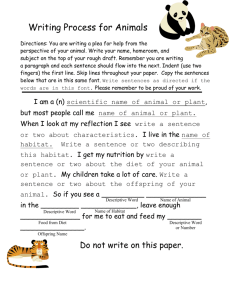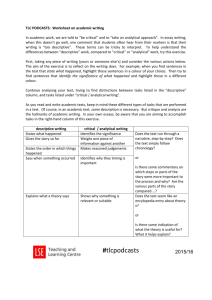FIRST GRADE - Read Tennessee
advertisement

ENGLISH STANDARDS OF LEARNING ENHANCED SCOPE and SEQUENCE FIRST GRADE WRITING LESSON PLANS Virginia Department of Education 2004 1 Introduction The sample lesson plans included in this document are expansions of the Virginia Department of Education’s Enhanced Scope and Sequence oral language lesson plans. They include TTAC suggestions for differentiation. This resource is intended to help teachers align their classroom instruction with the content found in English Standards of Learning. The sample lessons are based on sound research and provide a variety of ways to actively involved children in their learning. The lessons serve to supplement the instructional suggestions in the Houghton Mifflin Teacher’s Edition. While the sample lessons are exemplary, they by no means represent the scope of instruction that MCPS teachers are implementing in their classrooms. Teachers are invited to follow the lesson format in this document and write additional lessons to include in next year’s Curriculum Guide update. To submit an additional lesson, copy a page from this word document to your hard drive. Use the format to guide you as you type over it the appropriate information for your lesson. Submit the lesson by sending it as an attachment to bwojo@mail.mcps.org. Please submit your lessons throughout the year so that the Office of Curriculum can compile them for review by groups of teachers next summer. Virginia Department of Education 2004 2 WRITING Lesson Plan Details in Sentences Organizing Topic Written Communication Skills Related Standard(s) of Learning 1.11, 1.12 Objective(s) Given two sentences, the student will identify the more descriptive sentence and explain how descriptive words help make the author’s ideas clearer. Prerequisite Understandings/Knowledge/Skills Students are expected to describe people, places, things, and events. Students are expected to write complete sentences. Students are expected to revise their own writing. Students are expected to provide feedback to a partner about their writing. Students are expected to know how to visualize. Materials needed Teacher-created pairs of sentences that model vague language and descriptive language (e.g., “The dog went across the yard” vs. “The little brown dog ran quickly across the yard”) Lesson procedure 1. Ask the students to close their eyes. Explain that you are going to read a sentence to them. Their job is to visualize what you are describing. 2. After reading the vague sentence, ask students to describe what they have seen in their minds. 3. Ask the students to close their eyes again. This time read the descriptive sentence. Now ask students to describe what they see. Help students recognize that they are imagining very similar pictures because of the detailed description. 4. Ask the students to identify what words in the second sentence helped them visualize a similar picture. Explain that the job of an author is to help the readers see exactly what is in the author’s mind. 5. Have the students choose a story from their writing folders. Then they should find a sentence where they could add details. Students should write that sentence on a separate sheet of paper. 6. Tell the students to rewrite the sentence by adding details. 1. Have students meet with their writing partners to read the first and second sentence. The writing partner provides feedback on how the second sentence was or was not better than the first sentence. Specific options for differentiating this lesson Technology Provide access to a picture-symbol word processing program or a talking word processing program to write and edit. Use pictures or presentation software to model the vague and descriptive sentences. Multisensory Have students draw the descriptive and vague sentences using crayons to illustrate how much more detailed they can be when the sentence is descriptive. Write the model sentences on a chart or overhead. Highlight or color-code the descriptive words in the second sentence to visually show what words make this sentence better. Have students act out vague and descriptive sentences. Virginia Department of Education 2004 3 Community Connections Arrange for the class to attend a storytelling, poetry reading, or play to gain additional exposure to descriptive language. Ask the music teacher to provide examples of songs that demonstrate good use of descriptive language (America the Beautiful). Invite the cafeteria manager to the class to discuss the importance of using descriptive language in menus. Small Group Learning Have students sort sentences that are vague and descriptive in a learning center. Provide students with pictures from magazines and have them write sentences describing the pictures in a learning center. Have students rewrite their partner’s sentences using descriptive language. Have students work with partners to illustrate student-created sentences from the writing folders. Vocabulary Review the terms descriptive and vague. Student Organization of Content Lead a shared writing or interactive writing of vague sentences, which is made more descriptive using student input. Have students use highlighters to identify the descriptive words they have written independently. The teacher may lead a brainstorming session with students to come up with descriptive words that students can use in their writing. This web will remain posted in the classroom. Organize potential descriptive words according to categories (size, color, shape). Virginia Department of Education 2004 4 WRITING Lesson Plan Story Problems Organizing Topic Written Communication Skills Related Standard(s) of Learning 1.11, 1.12 Objective(s) The student will be able to state the topic of a story and identify digressions. Prerequisite Understandings/Knowledge/Skills Students are expected to identify the main topic in a story. Students are expected to identify sentences that stray from the topic. Students are expected to write complete sentences. Students are expected to provide feedback to a partner about their writing. Students are expected to follow basic rules of conversation. Materials needed Teacher-created story that has some intentional digressions from the central idea. Lesson procedure 1. Read the teacher-created story to the students. 2. Ask the students to identify potential problems with the story. Guide students to the conclusion that the story is confusing due to extraneous, off topic information. 3. Tell students to go to their writing folders and select a story. Have them read their stories with writing partners. Ask the students to state the topic of their partners’ stories and identify any places where the story details are not related to the topic. If a partner cannot identify the topic, participate in the conference and help the writer revise to focus on one topic. 1. Post a writing revision rule in your classroom: Writers should read their pieces to check for focus and then ask a writing partner to listen and identify the topic. Specific options for differentiating this lesson Technology Have students use a picture-symbol word processing program or a talking word processing program to write and edit. Have students use highlighter tape or highlighters to identify off topic sentences. Present the model story on the overhead, a word processing program with a projector, or on presentation software. Multisensory Write the model story on sentence strips and put them on a pocket chart. The teacher or student volunteers remove the off-topic sentences to provide a more concrete visual tool than crossing out the sentences. Write the model sentences on a chart or overhead. Highlight the off-topic sentences or have student volunteers come to the board to alter the model. Have students actively participate in a reading of a model that does not focus on one topic. Students will hold their thumbs up when the writing is on topic and will hold their thumbs down when the writing goes off topic. Community Connections Virginia Department of Education 2004 5 Invite local newspaper or television reporters to the class to discuss the importance of staying on topic when telling a story. Small Group Learning Have students read laminated stories that have off-topic details in a learning center. Have students use dry-erase markers to mark through the off-topic information. Give students pictures from magazines or calendars and have them write sentences that focus on the topic in the picture in a learning center. Model in front of the class how writing buddies will interact during their revision. This fish bowl activity will allow all students to see and discuss proper ways to interact with a partner while revising. Vocabulary Review the terms revising, main idea, and off-topic sentences. Student Organization of Content Give students individual copies of the revision rules to place in their writing folders for easier reference. The rules will be written with picture symbols and words so that students can understand the rules independently. Lead a shared writing or interactive writing of a story that includes blatantly off-topic sentences. The class then work together to revise this story. Create a revising checklist to post on a chart in the classroom. Partners will be given copies of this revising checklist in their writing folders. The checklist would clearly outline the steps students would take when working with their partner on identifying the main topic and off topic sentences. Virginia Department of Education 2004 6









